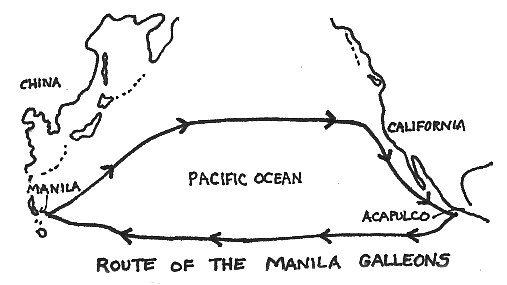| ||||
|
| ||||
|
SEBASTIAN
RODRIGUEZ CERMENO
 Lived:
in the late 1500s and early 1600s
Lived:
in the late 1500s and early 1600s
Explored California in: 1595
Exploring for: Spain
Explored: by sea along the California coast
Cermeño’s mission, given to him by the Spanish authorities
in New Spain (
EARLY HISTORY
Sebastián Rodríguez Cermeño (sometimes spelled Cermenho)
was born in
BACKGROUND
New Spain depended on the trade
goods brought from the Orient by the one galleon (ship) each year that was
allowed to make the trip between Acapulco (on the coast of New Spain) and
Manila (in the
The trip back to
The way the ocean currents ran
in the North Pacific made the route of the Manila galleons such that they
reached the coast of North
When Luis de Velasco became Viceroy of New Spain in 1590, he wanted to find a good harbor so the Manila galleons could put into port sooner after their rough ocean crossing, and get supplies. Previous suggestions of good harbors had been ignored. In 1594 Velasco hired Sebastián Cermeño to look again.
CERMENO’S JOURNEY
Cermeño left Acapulco in March 1594 with a flotilla (a small fleet) of ships. The crossing to Manila was accomplished and a new ship, the San Agustín, was loaded for the return trip. The San Agustín was an 80-foot galleon.
The load was an especially heavy one because Cermeño had been given permission to bring back several tons of goods for himself, which he could sell to make an extra profit. Also, he brought on board a small boat, called a launch, which was taken apart in sections so that it could be put together again when it was needed. He planned to use this launch to explore the bays and rivers on the California coast.
The San Agustín left Manila on July 5, 1595. The crossing from Manila to California was a rough one. They sighted land near Point St. George (near the border of Oregon and California) but then a bad storm came up. Cermeño’s crew were worried and wanted to pull back out to sea and head for Acapulco. Cermeño refused and sailed in close to the coast, rounded Point Reyes, and anchored in a little bay on November 14. He named it La Baya de San Francisco (the Bay of St. Francis, now known as Drake’s Bay).
Cermeño’s report of the trip included descriptions of his peaceful meetings with the Indians who lived here. Cermeño made camp on the beach and spent the next few days exploring the area. The crew put together the launch, for Cermeño wanted to explore every possible bay and river.
On November 30, 1595, another big storm hit. Gale winds blew the San Agustín aground and the waves pounded the big ship to pieces within a few hours. The ship, its entire cargo, and twelve men were lost in the wreck.
Now the men were glad that they had the small launch, the San Buenaventura. The 70 crewmen who were left crowded into the launch and set off for Acapulco. They had very few supplies, mostly acorns, fruit, and dried meat that the Indians had given them. Even then, Cermeño insisted on stopping all along the coast to check out every possible harbor. They continued to get food from Indians living along the coast. Without this help, the crew would not have survived. The San Buenaventura finally arrived back in Mexico in January 1596.
Rather than being a hero for bringing his crew safely back in such a small boat, Cermeño was in trouble with the government of New Spain for losing the San Agustín and all its cargo. Besides, he had not found a good port for the Manila galleons. The government decided not to trust his charts, in spite of how hard he had tried to do accurate mapping. The charts were not used by Spanish navigators who followed Cermeño.
WHAT HE ACCOMPLISHED
The chart of the California coast made by Cermeño was the most accurate that had been done up to that time. He described many points, including Monterey Bay which he charted more accurately than Vizcaíno did six years later.
One thing that Cermeño missed was the Golden Gate, the entrance to today’s San Francisco Bay. He simply sailed past without realizing that there was a narrow opening leading to a large bay. At Drake’s Bay (which Cermeño named the Bay of San Francisco because he was there on the feast day of St. Francis), he made no mention of any signs that the English seaman Francis Drake may have been there just 17 years before.
LATER YEARS
In the late 1990s, a team of divers led by the National Parks Service have been trying to locate the wreckage of the San Agustín off Point Reyes. They are using new equipment such as sub-bottom mapping sonar and an improved magnetometer (an instrument that measures magnetic fields). With these instruments, they have located several places where iron is buried beneath the ocean sand.
Iron nails and rods as well as broken pieces of Chinese porcelain have been found near this beach. The San Agustín was no doubt carrying Chinese porcelain as part of her cargo.